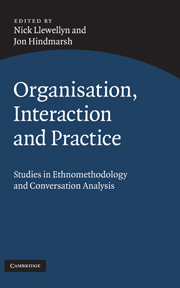Book contents
- Frontmatter
- Contents
- List of contributors
- Preface
- Part I Orientations
- Part II Studies
- 3 A kind of governance: rules, time and psychology in organisations
- 4 On the reflexivity between setting and practice: the ‘recruitment interview’
- 5 The situated production of stories
- 6 Orders of bidding: organising participation in auctions of fine art and antiques
- 7 Some major organisational consequences of some ‘minor’, organised conduct: evidence from a video analysis of pre-verbal service encounters in a showroom retail store
- 8 The work of the work order: document practice in face-to-face service encounters
- 9 The interactional accomplishment of a strategic plan
- 10 Peripherality, participation and communities of practice: examining the patient in dental training
- List of references
- Index
5 - The situated production of stories
the ‘recruitment interview’
Published online by Cambridge University Press: 20 May 2010
- Frontmatter
- Contents
- List of contributors
- Preface
- Part I Orientations
- Part II Studies
- 3 A kind of governance: rules, time and psychology in organisations
- 4 On the reflexivity between setting and practice: the ‘recruitment interview’
- 5 The situated production of stories
- 6 Orders of bidding: organising participation in auctions of fine art and antiques
- 7 Some major organisational consequences of some ‘minor’, organised conduct: evidence from a video analysis of pre-verbal service encounters in a showroom retail store
- 8 The work of the work order: document practice in face-to-face service encounters
- 9 The interactional accomplishment of a strategic plan
- 10 Peripherality, participation and communities of practice: examining the patient in dental training
- List of references
- Index
Summary
Introduction
At a general level storytelling is a pervasive feature of everyday discourse both within and outside organisations. Existing research on organisational stories indicates that they are not simply frivolous diversions that seek to amaze and entertain the recipients. Rather they may serve a number of important functions for organisations, which include socialising new organisational members by articulating the culture of an organisation; assisting with the development and verbalisation of visions and strategies; helping develop points of similarity within disparate and dispersed organisational groups; sustaining and legitimating existing power relationships as well as providing opportunities for resistance against them; and acting as collective organisational memory systems (Boje 1991, 1995, 2001; Boyce 1995; B. Clark 1972; Gabriel 1991, 1995; Moeran 2007; Mumby 1987; Wilkins 1983).
Whilst previous studies have produced important insights into various aspects of storytelling within organisations, a common failing has been their focus on the analysis of textual recordings of stories rather than an examination of their in situ production. It has generally been assumed that a story's original meaning and purpose, as conveyed when it was initially told, is apparent from an analysis of a textual record of this event. With notable exceptions (e.g. Boje 1991, 1995, 2001), storytelling has not been viewed as a situated communicative act. This is surprising given that, as David Boje (2001) demonstrates, studying storytelling episodes as situated communicative acts, which are shaped not only by storytellers but also by story recipients, is critical to understanding their form, function and reception.
- Type
- Chapter
- Information
- Organisation, Interaction and PracticeStudies of Ethnomethodology and Conversation Analysis, pp. 96 - 118Publisher: Cambridge University PressPrint publication year: 2010
- 3
- Cited by

